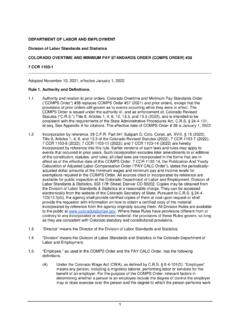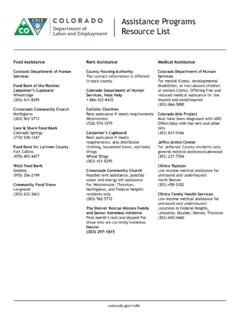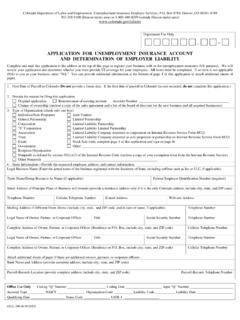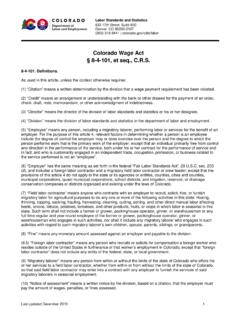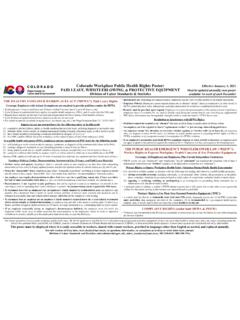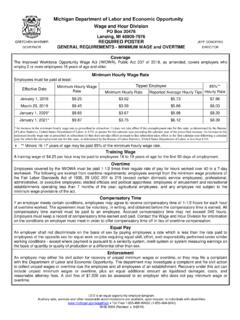Transcription of DEPARTMENT OF LABOR AND EMPLOYMENT Division of …
1 DEPARTMENT OF LABOR AND EMPLOYMENTD ivision of LABOR Standards and StatisticsCOLORADO overtime AND MINIMUM PAY STANDARDS ORDER (COMPS ORDER) #377 CCR 1103-1_____Adopted on November 10, 2020, effective January 1, 2021. Rule 1. Authority and and relation to prior orders. Colorado overtime and Minimum Pay Standards Order ( COMPS Order ) #37 replaces COMPS Order #36 (2020) and prior orders, except that the provisions of prior orders still govern as to events occurring while they were in effect. The COMPS Order is issued under the authority of, and as enforcement of, Colorado Revised Statutes ( ) Title 8, Articles 1, 4, 6, 12, and (2021), and is intended to be consistent with the requirements of the State Administrative Procedures Act, 24-4-101, et seq. See Appendix A for citations. The effective date of COMPS Order # 37 is January 1, by reference.
2 20 , ; 29 Part 541 Subpart G; art. XVIII, 15 (2021); Title 8, Articles 1, 4, 6, and of the Colorado Revised Statutes (2021); 7 CCR 1103-7 (2021); and 7 CCR 1103-8 (2021) are hereby incorporated by reference into this rule. Earlier versions of such laws and rules may apply to events that occurred in prior years. Such incorporation excludes later amendments to or editions of the constitution, statutes, and rules; all cited laws are incorporated in the forms that are in effect as of the effective date of this COMPS Order. All sources cited or incorporated by reference are available for public inspection at the Colorado DEPARTMENT of LABOR and EMPLOYMENT , Division of LABOR Standards & Statistics, 633 17th Street, Denver CO 80202. Copies may be obtained from the Division of LaborStandards & Statistics at a reasonable charge.
3 They can be accessed electronically from the website of the Colorado Secretary of State. Pursuant to 24-4-103( )(b), the agency shall provide certified copies of them at cost upon request or shall provide the requestor with information on how to obtain a certified copy of the material incorporated by reference from the agency originally issuing them. All Division Rules are available to the public at Where these Rules have provisions different from or contrary to any incorporated or referenced material, the provisions of these Rules govern, so long as they are consistent with Colorado statutory and constitutional Director means the Director of the Division of LABOR Standards and Division means the Division of LABOR Standards and Statistics in the Colorado DEPARTMENT of LABOR and Employee has the following definitions:(A)under the Colorado Wage Act (CWA), the definition in 8-4-101(5), ( Employee means any person, including a migratory laborer, performing LABOR or services for the benefit of an employer.)
4 For the purpose of this article 4, relevant factors in determining whether a person is an employee include the degree of control the employer may or doesexercise over the person and the degree to which the person performs work that is the primary work of the employer; except that an individual primarily free from control and direction in the performance of the service, both under his or her contract for the 1 Division of LABOR Standards and Statistics, COMPS Order #37 (effective January 1, 2021) 7 CCR 1103-1performance of service and in fact, and who is customarily engaged in an independent trade, occupation, profession, or business related to the service performed is not an employee . ); and.(B) under the Healthy Families and Workplaces Act (HFWA), the definition in (4) ( Employee has the meaning set forth in section 8-4-101(5).
5 Employee does not include an employee as defined in 45 sec 351(d) who is subject to the federal Railroad Unemployment Insurance Act , 45 sec. 351 et seq. ). Employer, has the following definitions:(A)under CWA, the definition in 8-4-101(6) ( Employer has the same meaning as set forth in the federal Fair LABOR Standards Act , 29 sec 203 (d), and includes a foreign LABOR contractor and a migratory field LABOR contractor or crew leader; except that the provisions of this article 4 do not apply to the state or its agencies or entities, counties, cities and counties, municipal corporations, quasi-municipal corporations, school districts, and irrigation, reservoir, or drainage conservation companies or districts organized and existing under the laws of Colorado. ); and (B)under HFWA, the definition in (5) ( Employer has the meaning set forth in section 8-4-101(6); except that the term includes the state and its agencies or entities, counties, cities and counties, municipalities, school districts, and any political subdivisions of the state.
6 [but] does not include the federal government. ). Minor, for purposes of wage provisions specific to minors, means a person under 18 years of age, but not one who has received a high school diploma or a passing score on the general educational development examination. Emancipated minor means any individual less than eighteen years of age who meets the definition provided by Regular rate of pay means the hourly rate actually paid to employees for a standard, non- overtime workweek. Employers need not pay employees on an hourly basis. If pay is on a piece-rate, salary, commission, or other non-hourly basis, any overtime compensation is based on an hourly regular rate calculated from the employee s included in regular rate. The regular rate includes all compensation paid to an employee, including set hourly rates, shift differentials, minimum wage tip credits, non-discretionary bonuses, production bonuses, and commissions used for calculating hourly overtime rates for non-exempt employees.
7 Business expenses, bona fide gifts, discretionary bonuses, employer investment contributions, vacation pay, holiday pay, sickleave, jury duty, or other pay for non-work hours may be excluded from regular rate for employees paid a weekly salary or other non-hourly basis.(A)A weekly salary or other non-hourly pay may be paid as straight time pay for all work hours, and the regular rate each workweek will be the total paid divided by hours worked, if the parties have a clear mutual understanding that the salary is:(1)compensation (apart from any overtime premium) for all hours each workweek;(2)at least the applicable minimum wage for all hours in workweeks with thegreatest hours;(3)supplemented by extra pay for all overtime hours (in addition to the salary that covers the regular rate) of an extra of the regular rate; and2 Division of LABOR Standards and Statistics, COMPS Order #37 (effective January 1, 2021) 7 CCR 1103-1(4)paid for whatever hours the employee works in a workweek.
8 (B)Where the requirements of (1)-(4) are not carried out, there is not the required clear mutual understanding that the non-hourly pay provides the regular rate forall hours with extra pay added for overtime hours. Absent such an understanding,the hourly regular rate is the applicable weekly pay divided by 40, the number of hours presumed to be in a workweek for an employee paid no overtime Time worked means time during which an employee is performing LABOR or services for the benefit of an employer, including all time s/he is suffered or permitted to work, whether or not required to do or permitting employees to be on the employer's premises, on duty, or at a prescribed workplace (but not merely permitting an employee completely relieved from duty to arrive or remain on-premises) including but not limited to, if such tasks take over one minute, putting on or removing required work clothes or gear (but not a uniform worn outside work as well)
9 , receiving or sharing work-related information, security or safety screening, remaining at the place of EMPLOYMENT awaiting a decision on job assignment or when to begin work, performing clean-up or other duties "off the clock," clocking or checking in or out, or waiting for any of the preceding shall be considered time worked that must be Travel time means time spent on travel for the benefit of an employer, excluding normal home to work travel, and shall be considered time worked. At the start or end of the workday, travel to or from a work station, entirely within the employer's premises and/or with employer-provided transportation, shall not be considered time worked, except that such travel is compensable if it is:(A)time worked under Rule ;(B)after compensable time starts or before compensable time ends under Rule ; or(C)travel in employer-mandated transportation (1) that materially prolongs commute time or (2) in which employees are subjected to heightened physical risk compared to an ordinary Sleep time means time an employee may sleep, which is compensable as follows.
10 Where an employee's shift is 24 hours or longer, up to 8 hours of sleeping time may be excluded from overtime compensation, if:(A)an express agreement excluding sleeping time exists;(B)adequate sleeping facilities for an uninterrupted night's sleep are provided;(C)at least 5 hours of sleep are possible during the scheduled sleep period; and(D)interruptions to perform duties are considered time an employee s shift is less than 24 hours, periods when s/he is permitted to sleep are compensable work time, as long as s/he is on duty and must work when required. Only actual sleep time may be excluded, up to a maximum of 8 hours per workday. Whenwork-related interruptions prevent 5 hours of sleep, the employee shall be compensated for the entire of LABOR Standards and Statistics, COMPS Order #37 (effective January 1, 2021) 7 CCR Tipped employee means any employee engaged in an occupation in which s/he customarily andregularly receives more than $30 per month in tips.
